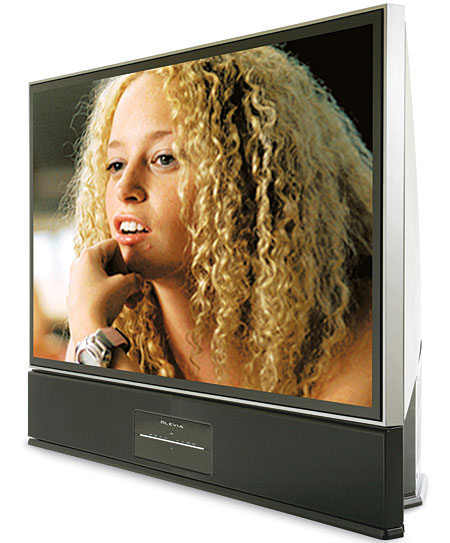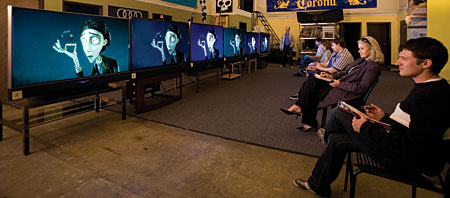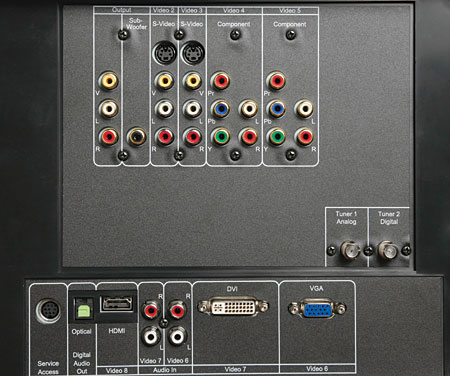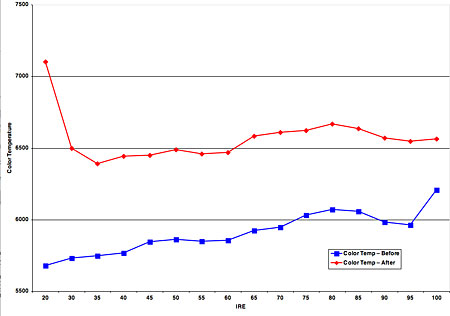The 2007 1080p RPTV Face Off Olevia 565H LCOS HDTV
So much done right, but. . .
Olevia, a sub-brand of Syntax-Brillian, is a relative newcomer to the TV world. While most companies are content to race to zero on the low end of the market, Syntax-Brillian decided to step in and fight with the big dogs. This, and the fact that they proudly use high-end scalers in most of their displays, made them a no-brainer for this Face Off.

The 565H had a lot going for it, at first. There were multitudes of inputs, and, like only one other TV in the Face Off, the 565H accepts 1080p over all of the HD inputs (including component). The remote is by far the most attractive of the bunch, and it's backlit. It doesn't have direct-input access, but the source button instead pulls up a list of inputs to select from. Few of the judges were enamored of the TV's aesthetics, and Adrienne commented that the front-panel controls were too obvious.

Like only one other TV in the Face Off (the JVC), the 565H correctly deinterlaces 1080i/30 and correctly detects the 3:2 sequence in 1080i material. This is no doubt due to the Pixelworks DNX chip. With 480i material, the Olevia also picked up the 3:2 sequence quickly, both with synthetic tests and real video material. With 480i sourced from video (like the waving flag from the Silicon Optix test DVD), the Olevia showed almost no jagged edges.
 A contrast ratio of 3,880:1 is in the lower half of this group, but it's still quite respectable. The overall light output of 135.8 foot-lamberts is the second highest in this group, but so is the black level of 0.035 ft-L. To make that worse, the blacks had a bluish tint, even after calibration. Due to some strong competition, there were many comments about how high the black level was. These were usually accompanied by remarks like "washed out." The color points, like those of all of the LCOS sets in this Face Off, were oversaturated.
A contrast ratio of 3,880:1 is in the lower half of this group, but it's still quite respectable. The overall light output of 135.8 foot-lamberts is the second highest in this group, but so is the black level of 0.035 ft-L. To make that worse, the blacks had a bluish tint, even after calibration. Due to some strong competition, there were many comments about how high the black level was. These were usually accompanied by remarks like "washed out." The color points, like those of all of the LCOS sets in this Face Off, were oversaturated.
So, where did this set go wrong? Well, I can sum that up with a word that appeared on each of our judges' questionnaires: soft. Across every selection, this TV was noticeably softer than the others. As it was soft with both SD and HD, it's doubtful that it's a scaling issue. The measurements back up this theory. Using our Leader LT-446 test generator, we only measured 990 lines of resolution with 1080i material. Using an advance copy of the Silicon Optix test HD DVD, the 565H could just barely resolve a one-pixel-on/
one-pixel-off pattern vertically and not at all horizontally (as was the case with two other displays here). One pixel on/one pixel off is a portion of a larger pattern. This portion consists of thin alternating white and black lines that are one pixel wide, and it tests the absolute limit of a TV's resolution.
Without the softness issue, the 565H probably would have moved up a few slots. After all, it seemed to decode images very well, and its contrast ratio and black level weren't bad. (The average here was better than normal.) When we do this again next year, there will hopefully be a new Olevia model that keeps what this one does right and finds some of that lost detail. That would be very interesting.
Highlights
• Excellent Processing
• Component, HDMI, and DVI all accept 1080p
At A Glance: Olevia 565H LCOS HDTV

Features
Type: LCOS
Screen Size (diagonal): 65 inches
Native Resolution: 1080p
Lamp Life: 4–6,000 hours
Dimensions (H x W x D, inches): 45 x 60.1 x 23
Weight (pounds): 122
Price: $4,300
Connections
Inputs:
Video: HDMI (1), DVI (1), compo- nent video (2), S-video (2, shared), composite video (2, shared)
Audio: None
Outputs:
Video: Composite video (1)
Audio: Analog stereo (1), optical (1), RF (2)
Additional: Subwoofer (1), PC-RGB (1)
Ratings: Olevia 565H LCOS HDTV
Build Quality: 85
Value: 84
Features: 90
Performance: 83
Ergonomics: 90
Overall Rating: 85
General Information
565H LCOS HDTV, $4,300
Olevia
(866) OLEVIA
www.olevia.com
Dealer Locator Code OLE
HT Labs Measures: Olevia 565H LCOS HDTV


Full-On/Full-Off Contrast Ratio—3,880:1; ANSI Contrast Ratio—338:1
Measured Resolution with the Leader LT-446:
480: 450 (per picture height)
720p: 720 (pph)
1080i: 990 (pph)
DC Restoration (poor, average, good, excellent): Excellent
Color Decoder (poor, average, good, excellent): Excellent
Measured Color Points:
Red Color Point: x=0.671, y=0.325
Green Color Point: x=0.302, y=0.685
Blue Color Point: x=0.144, y=0.049
The left chart shows the Olevia 565H's gray scale relative to its color temperature at various levels of intensity, or brightness (20 IRE is dark gray; 100 IRE is bright white). The gray scale as set by the factory, in the Warm color-temperature mode, measures very warm with dark images and slightly less warm with brighter images. After making adjustments using the Photo Research PR-650, the gray scale measures much closer to D6500, the accurate color temperature, across most of the rest of the range. The darkest images are rather cool.
The right chart shows the gray scale (or color temperature) relative to the color points of the display's red, green, and blue LCOS panels. These are off those specified by SMPTE. Red is rather oversaturated. Blue is slightly oversaturated. Green is very oversaturated and very slightly yellowish-green.
After calibration, and using a full-field 100-IRE white (135.8 foot-lamberts) and a full-field 0-IRE black (0.035 ft-L), the contrast ratio was 3,880:1. Using a 16-box checkerboard pattern (ANSI contrast), the contrast ratio was 338:1. The best contrast ratio was achieved in the Bright setting. All three modes had the same black level.—GM





























































